Diving experiences of Ruud & Odette

|
Barbados, Holetown/St. James May 1999 |
| For our annual escape of the Dutch summer, which we expected to be cold, dark and rainy as usual, we decided that Barbados might be the solution. So Barbados, or Little England as is it also known, it was to be for our May holiday. And did it solve our summer "blues": the sun was blazingly hot, the water warm, a light breeze to cool us down, just as we like it. Although not famous for its under water world - Barbados doesnít have the reputation of Bonaire, Cozumel or Belize - you could do a lot worse. In fact, Barbados is as beautiful as Bonaire, but offers even more variety in dive sites. |
| We had chosen an apartment in Holetown in the parrish of St. James on the west coast. Most of the dive sites are on the west and south coast of Barbados, so we would be right in the middle of it. Especially because thereís a marine park close to Holetown. We had not booked a dive package beforehand; we like to check out dive centers ourselves before deciding with whom we want to dive. Our rep advised us a dive center by the name of Guide by Side (owned and operated by Ravi, a Padi master instructor, tel. 001.809.420.2135, email address: sanravi@sunbeach.net) as being of good reputation, efficient and reasonable in price. He was absolutely right. We checked out other dive centers too and although we didnít compare their actual service, we did compare prices and boy, do they know what to chargeÖ. |
| Guide by Side doesnít have a location on the seaside, but thatís no problem at all. They have a free pick up from and to your hotel, so the dragging along with equipment is reduced to a minimum. They use 12 liter steel tanks, so be sure to adjust your weights properly if youíre used to aluminum tanks. At the time we were diving with them they were operating a small boat, very well suited for the conditions in which it has to sail, without a sunscreen but with a radio aboard (but as of June or July there would be a slightly bigger one, as we were told). Itís part of their philosophy: this way they can only accomodate small groups (max. 5 or 6 divers), the reef or wreck is less crowded (and donít we, divers, just love that) and they can pay more attention to the individual diver. Their rates are very reasonable indeed: a dive package of 10 costs Bds 500 (2 Bds is US$ 1), but if you have your own equipment thereís a discount of 10%. For comparison: other dive centers charge US$300-350 or Bds. 600-700 for a ten pack with your own equipment. And their service is outstanding (no, youíre wrong, theyíre not paying us to say this). Guide by Side try to accomodate you any which way they can, they pick out different dive sites every time, just to make sure that your diving is as varied as possible, with wrecks and reefs, easy diving and/or more challenging if you want to. Guide by Side can even arrange accommodation which suits your wishes, needs and budget for your stay on the island. |
| On our first diving day (as on all the others) Collin, from Guide by Side, picked us up at our apartment and transported us to the boat for our first dive at the SS Stavronikita, a 365 ft. freighter of which the deck is at nearly 100 ft. One of the many wrecks in the waters around Barbados, itís the most challenging because of its depth. Our divemaster was David, instructor at Guide by Side. The current was unexpectedly strong so our descend was along the mooring line. At some five meters thereís another line attached to the line. Be careful with that one if your wearing shorties, because in a strong current the rope may well "stroke" you. It happened to Ruud, who suffered an agonizing burning sensation and blisters from the numerous nematocysts that "attacked" his thigh, from the knee up to his shorty. Not a pleasant feeling, he can assure you. The Stavro is a well preserved wreck, grown with various sponges and full of life. Barracudas are regulars, as well as the numerous parrotfish, damselfish, soldierfish etc. The wreck is stripped, so that even a not too experienced wreck diver can swim through it in a safe manner. Because of its depth, the visit to the Stavro is a short, but worthwile one. We had to cancel the planned second dive, because of Ruuds encounter with the nematocysts. His leg was hurting too much, he was not feeling good at all and we all know about stress and diving. It must be said that Ravi and David were very concerned with Ruudís wellbeing. Ravi took the trouble of visiting a pharmacy in order to get some medicine (and he wouldnít hear of paying for them) to reduce the pain and the burning and he even called in the evening to inquire after Ruudís health. |

| Two days later we went diving again at Outer Caribbee and Pieces of Eight on the south coast, quite near St. Lawrence Gap. Two beautiful reefs, with lots of coral and sponges, moray eels and shrimps. We saw our first (of many more to come) turtle. This time Earl (or Errol) was our divemaster and he did a great job. In day to day life heís with the coast guard. On the second dive I had difficulty equalizing (damned airco, I should have known better than to use it) and because I never have trouble equalizing, I got angry and forced things just a little too much. The dive was relatively problemfree, but afterwards I was rewarded for my stubborness with pain in the ears. Another visit to the pharmacy and a couple of days of unwanted rest solved my problems. And again Ravi was calling, this time to inform after my wellbeing. Luckily for us, and for Ravi, we had no more real problems after that. |
| After my ears had settled down we started to dive again. Our first destination: Fork Reef. Excellent and relaxed dive. There was a huge green moray eel just waiting to have his picture taken, as was the big honeycomb cowfish. Boy, do they swim in a funny way. You would expect a fish to be more familiar with swimming.... The second dive was in Carlisle Bay, home to several wrecks at a shallow depth. On one of the wrecks thereís a juvenile spotted moray. Lovely. Less lovely, but very impressive was the big spotted scorpionfish. |
| The next day we re-visited the Stavro and found it to be a much more relaxing dive than the first time, because the current was down to zero. Ruud nevertheless did not come near the mooring line, for obvious reasons. At Bell Buoy, our second dive of the day, we had another encounter with turtles and morays (of which there are plenty). |
| Both Muff and Boot (less known dive site) are reefs teeming with life and full of gorgonians, corals and sponges. Again there were turtles (it gets boring....), peacock flounder and a channel flounder. The third dive of the day was the most impressive: Carlisle Bay at "night". It was to be a shore dive, because the wrecks (yes: multiple) in Carlisle Bay are located quite near the shoreline and on a shallow depth. Perfect for night diving. And fabulous too. The wrecks offer a very different sight at a night dive. Every location does, but wrecks even more so. Itís really exciting nearing a wreck at night (let alone swimming through one). The way it just dooms up in the beam of your light, wonderful! And these wrecks are bursting with life. We saw our dinner crawling in the light of our lamps: a huge spotted lobster, just waiting to be taken along, a few big coral crabs, shrimpsÖ. Mouthwatering! Unfortunately luck ran out again: my mask was constantly filling with water. As I was about to abort the dive (couldnít see a thing and sea water is very salty in your eyes...) Ravi stopped me and offered to switch masks. At first I didnít think it would be a good idea - he was supposed to guide us and how can you do that if you canít see a thing - but heís the instructor and if heís willing to let this spoil his dive too... be my guest. My dive was great and so was Raviís, for guess what.... no water in "his" mask. But because I had had my share of stress for one dive, I decided not to enter one of the wrecks, although Ruud was already in. I followed him on the outside and was I glad I did that... suddenly he seemed to stand upright and pull himself up along a ladder of some kind, wriggling himself through holes and gangways as if he had never done anything else. Macho! |

| The next day we went to Asta Reef and Friarís Craig. The current was strong and we had difficulty reaching Friarís Craig, which is and old and damaged wreck. I managed to reach it and was thankful for the leeward side of the wreck, for here I could catch my breath. And see another turtle. |
| At Clarks Reef, the location where the submarine with non-divers goes down to enjoy the views, we had a bad dive. The current was ripping, and we had to swim against it for a while. Because we prefer a drift dive without swimming (call us lazy) we aborted the dive. The dive at Lord Combermere was better in every sense of the word: no current, beautiful wreck with giant anemones and Pederson cleaner shrimps, a small golden tail moray, a spotted moray with a cleaner shrimp, whitespotted file fish. Beautiful dive. |
| Our last dives were at Dottins and Little Sandy Lane on the west coast. Guess what: turtles, barracuda, porcupinefish, scrawled filefish, a couple of bluestriped lizardfish. That and more in a relaxed dive, without a current. Lucky shot for, when we were back on the boat, we heard that a search party had to be organised to recover some divers on the south coast. Apparently they had been diving without a captain on the boat (not too smart), and because of the strong current there they had no chance of getting back to the boat, which was anchored up-current. The rescue party mentioned, after they had found the divers, that they had even sighted some whales close to shore, which is kind of unusual because they tend to pass Barbados far from the coastline. But apparently the current had driven them closer to shore. Apart from the whales Barbados has no fish bigger than barracuda, but plenty of turtles can be seen. |

| And how about Barbados above sea level? To be honest, we were a little disappointed. Itís a charming island, donít get us wrong, with palm trees, plenty of beautiful flowers, plantations in a slightly hilly countryside. The west coast, the Caribbean side, has sandy beaches and calm waters; the eastern side on the Atlantic has beautiful beaches with big waves crashing against the rocks. Barbados, at least the south and especially the west coast, is reasonably developed and I hate it when, being far from home, my shoppings in a supermarket are scanned with a barcode reader. It just doesnít have that special, relaxed Caribbean atmosphere. Barbados has known tourism for many years and it shows. With exceptions to the rule (thank goodness) the "Bajans", as they call themselves, are not a happy or overly friendly people. In shops, supermarkets, buses and in some restaurants they are not too eager to help, a smile seems to hurt (although we were smiling at them until our cheeks hurt) and a friendly "please" or "thank you" is too much to ask for. But again: there were exceptions to the rule! The capital Bridgetown is loaded with tax free shopping possibilities (great if youíre looking for it, but we were not), but doesnít have a cosy or real historic center. Thereís a replica of the Big Ben at Trafalgar Square (still wondering why they call it "Little England"?). Holetown, in the midwestern coastal part, is mostly just a line of hotels and restaurants along the highway and on the beach. Speightstown, a little more to the northern part of the western shore, is more of a Caribbean town. A town where you can still see how the local people live, love, shop, eat and drink. Perhaps we should have made more effort to visit the rest of the island, but with diving so much and with the experience we had with Bridgetown, we decided against it. And most probably thatís our loss, because the rest of the island would have proven us wrong, weíre sure. So donít let our experience influence you too much. |
| Itís quite easy to travel the island on your own, even without hiring a car (driving is on the left hand side). Local transportation is good: there are blue buses with a yellow stripe (government run) and yellow buses with a blue stripe, which will take you for as little as Bds 1.50 any which way you want. But remember to pay the same amount again if you change buses. The blue buses go a little slower (and will keep your adrenalin level within its boundary, if you know what I mean), are less crowded (nice with such temperatures) and take slightly longer routes, but thatís only great if youíre touring the island. Taxis are plenty and affordable. And as weíve heard: if you cruise the island in a rental car you can get lost (road signs are scarce), but youíll always find your way home somehow. And thatís a comforting thought, isnít it. |
| If you want to contact Guide by Side for diving and/or accommodation, hereís the address again (theyíre working on a website at the moment): Guide by Side Attn. Ravi and/or Sandrina (Raviís charming and pretty wife) Tel./fax 001-809-420-2135. sanravi@sunbeach.net |
| All pictures on this page are made by Ruud Koster with a Nikonos V camera, 35 mm standardobjective, Sunpak 3200 flash, Ikelite 5002 vieuwfinder and Fuji 200 ASA film. |

